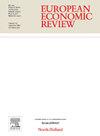Reallocation, productivity, and monetary policy in an energy crisis
IF 2.8
2区 经济学
Q1 ECONOMICS
引用次数: 0
Abstract
This paper presents a New Keynesian multi-sector model incorporating firm heterogeneity, entry-exit dynamics, and energy production from both fossil fuels and renewables. We investigate the effects of a sustained increase in fossil fuel prices on sectoral size, labor productivity, and inflation. A rise in fossil fuel prices leads to higher energy costs. Due to ex-ante heterogeneity in energy intensity, sectoral profitability is impacted asymmetrically. As production costs rise, new entrants must have higher idiosyncratic productivity to remain profitable, boosting average labor productivity but reducing firm entry and the number of active firms in each sector. When the price effects of the shock are persistent, a central bank with a strong anti-inflationary stance can mitigate the resulting inflation by curbing wage costs. This policy entails higher output costs and a milder response in average productivity, but enables a faster recovery in business dynamism. Our results thus reveal a novel trade-off for monetary policy between stabilizing aggregate activity and business dynamism.
能源危机中的再分配、生产率和货币政策
本文提出了一个新凯恩斯主义的多部门模型,该模型将企业异质性、进入-退出动态以及化石燃料和可再生能源的能源生产结合起来。我们研究了化石燃料价格持续上涨对行业规模、劳动生产率和通货膨胀的影响。化石燃料价格上涨导致能源成本上升。由于能源强度的事前异质性,部门盈利能力受到不对称的影响。随着生产成本的上升,新进入者必须有更高的特殊生产率才能保持盈利,这提高了平均劳动生产率,但减少了企业进入和每个部门活跃企业的数量。当冲击对价格的影响持续存在时,持强硬反通胀立场的央行可以通过抑制工资成本来缓解由此产生的通胀。这一政策导致更高的产出成本和平均生产率较温和的反应,但能够更快地恢复商业活力。因此,我们的研究结果揭示了货币政策在稳定总活动和商业活力之间的一种新的权衡。
本文章由计算机程序翻译,如有差异,请以英文原文为准。
求助全文
约1分钟内获得全文
求助全文
来源期刊

European Economic Review
ECONOMICS-
CiteScore
4.70
自引率
3.60%
发文量
170
期刊介绍:
The European Economic Review (EER) started publishing in 1969 as the first research journal specifically aiming to contribute to the development and application of economics as a science in Europe. As a broad-based professional and international journal, the EER welcomes submissions of applied and theoretical research papers in all fields of economics. The aim of the EER is to contribute to the development of the science of economics and its applications, as well as to improve communication between academic researchers, teachers and policy makers across the European continent and beyond.
 求助内容:
求助内容: 应助结果提醒方式:
应助结果提醒方式:


